Motorola Droid RAZR Review - A Better Clad Bionic
by Brian Klug on December 16, 2011 2:01 AM EST- Posted in
- Smartphones
- Droid
- LTE
- 4G
- Motorola
- Android
- Mobile
- Droid RAZR
- motorola droid RAZR
Software - Android 2.3.5
As of this writing, the RAZR is running Android 2.3.5, and in almost any other context it’d be easy to applaud Motorola for shipping close to the absolute bleeding edge branch of Android 2.3, but there’s no way to ignore the fact that this isn’t Android 4.0. It’s a bit unfortunate for everyone that we’re seeing a repeat of last year with devices on the market running an older version of Android than what’s currently available on AOSP, but porting and certification takes time. We’ve outlined it already, but Motorola has stated that the RAZR will get its own Android 4.0 Ice Cream Sandwich update before 2Q 2012, but that’s a long potential 6 months to wait for the latest version of Android - a quarter of your 2 year contract.
The flipside of the argument is that it’s at least guaranteed to happen sometime before then, and thus the more important comparison for the RAZR becomes how its hardware compares to the Galaxy Nexus, which we’ll talk about in the context of that device review. The short thing to note is that the two are both based on an OMAP4 SoC, so performance will likely be close between the two.
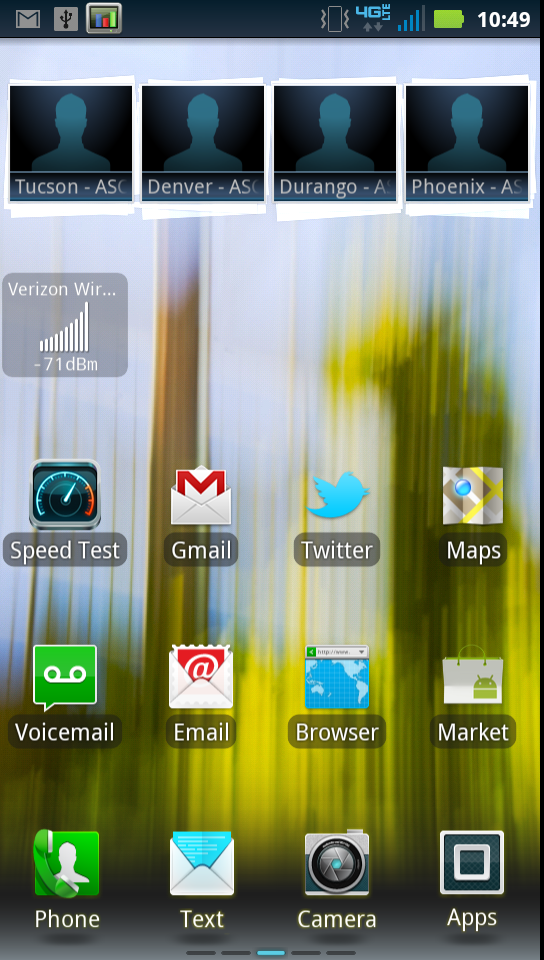
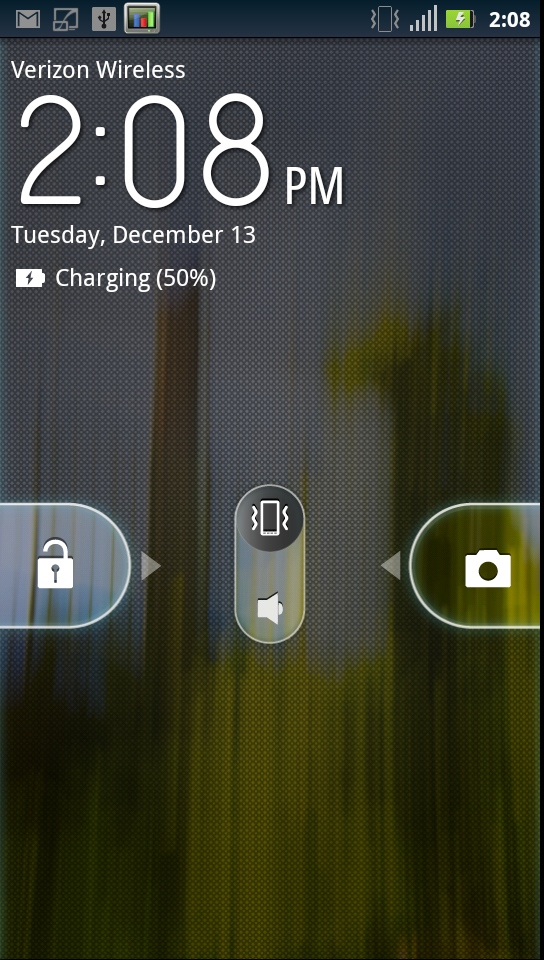
Anyhow, Android 2.3.5 on the RAZR is almost identical to the software and Blur skin we saw running on the Droid Bionic. That is to say, both come with Motorola’s not-Blur motoblur skin replete with resizable widgets, 3D launcher with a paginated 4x5 grid of icons, Motorola’s own slightly tweaked home screens, blue and grey Android UI colors, and basically the same software preload, but that’s not to say there aren’t some major changes.
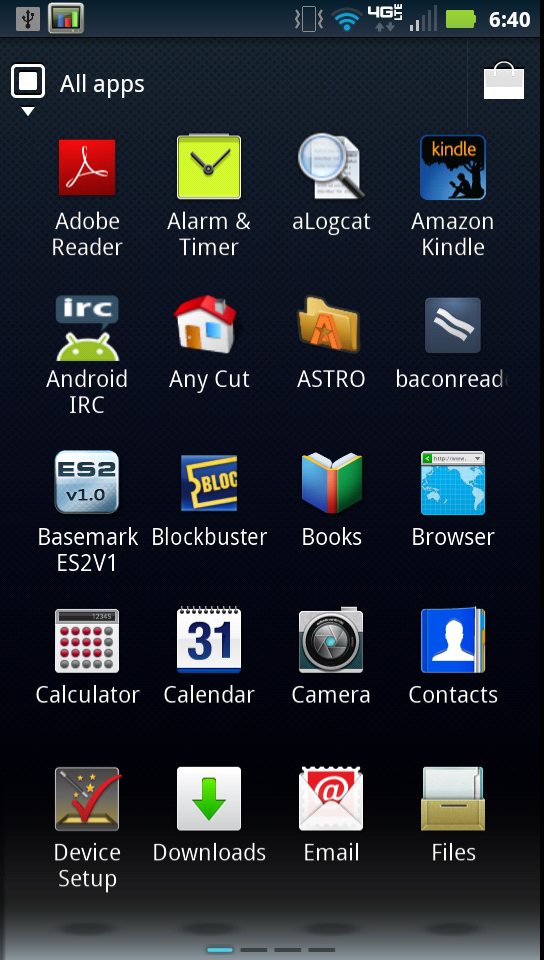
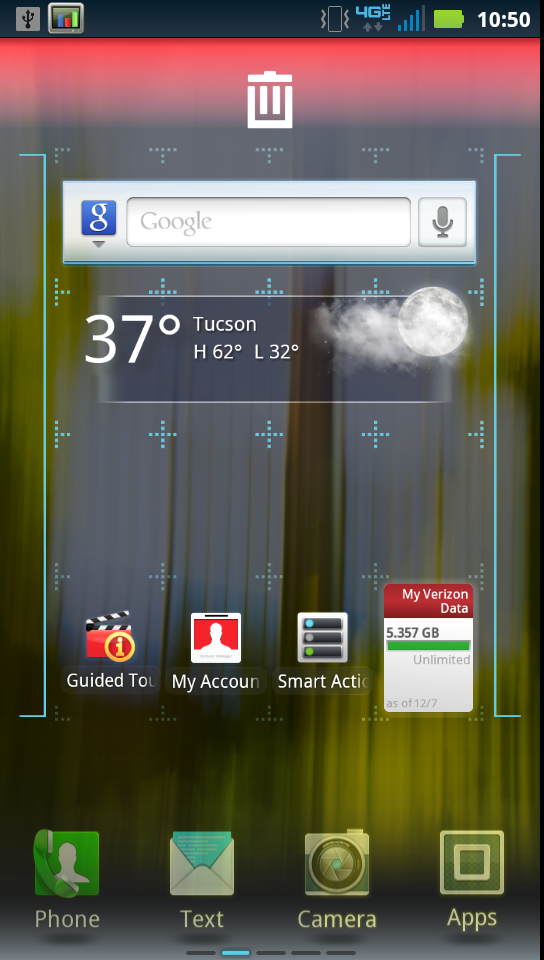
If you recall back to the Bionic review, I noted that device’s Blur version, which was 5.5.886. On the RAZR, Blur is now:
Blur_Version.6.11.777.XT912.Verizon.en.US
This change incorporates a bunch of new features. First up is a new lock screen with a quick shortcut that gets you right into the camera (something that basically everyone seems to be doing right now) and still gives the same vibrate/silent and date/time informatics at the top.
The other big change is the addition of so-called “Smart Actions” which really are location, time, and other trigger defined rules. There are a variety of preconfigured samples that you can tailor and build off of, for example to silence your phone when your location is at work or between certain hours, or remind you to charge your phone before sleep. It’s similar to Reminders for iOS but with more system integration and using other hooks in the OS for doing more than just location or time based alerts.
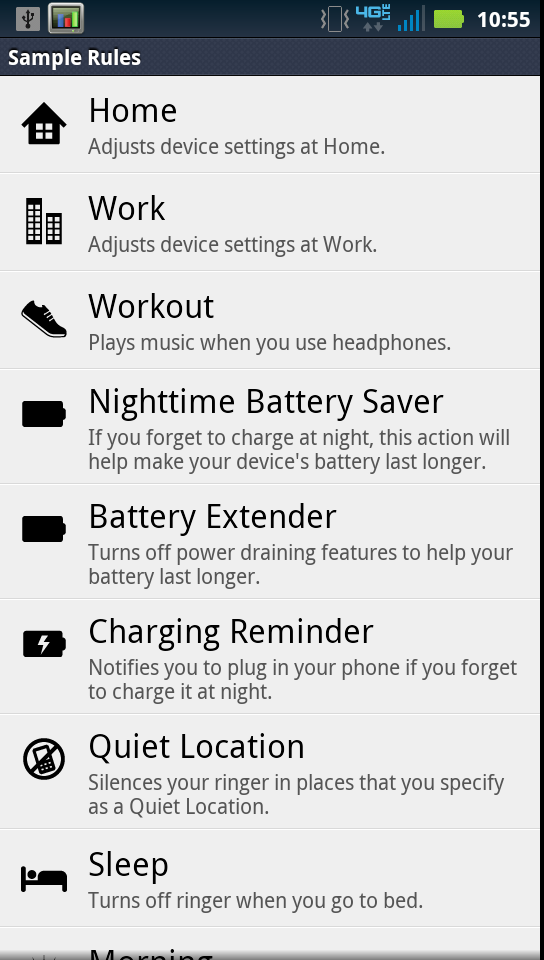
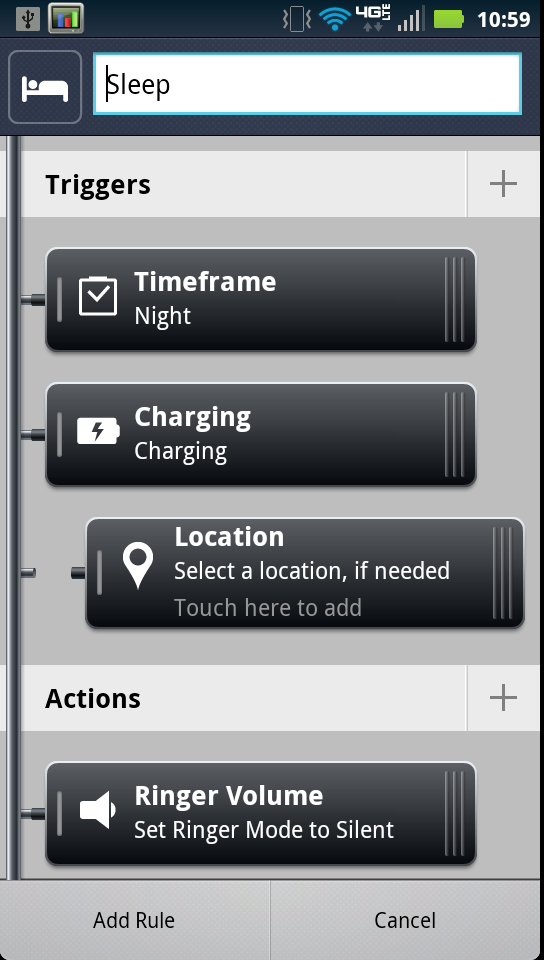
I usually have all my mobile devices on vibrate all the time, but having time and location-triggered silence mode is a far-overdue functionality for smartphones. It’s a lifesaver if you’re in a workplace or classroom where email and SMS alerts are frowned upon - or worse.
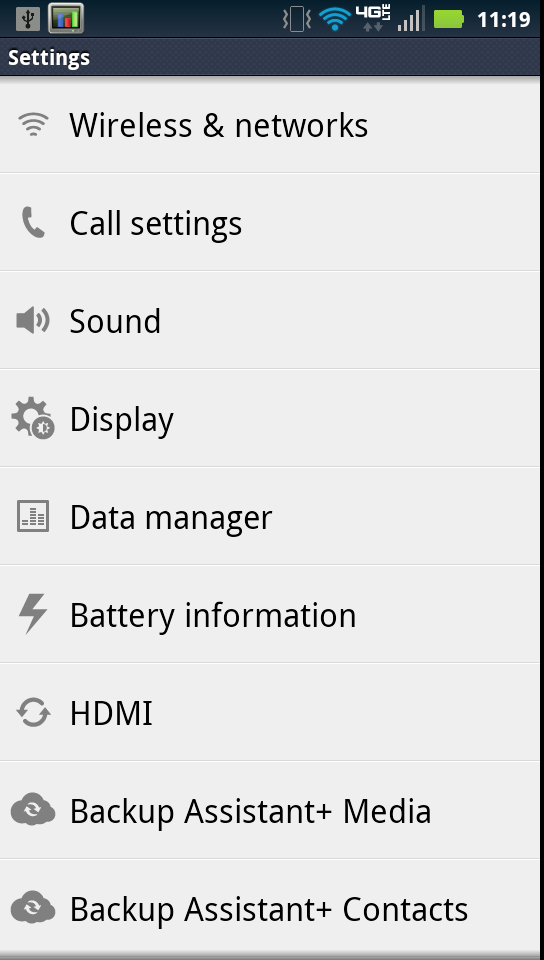
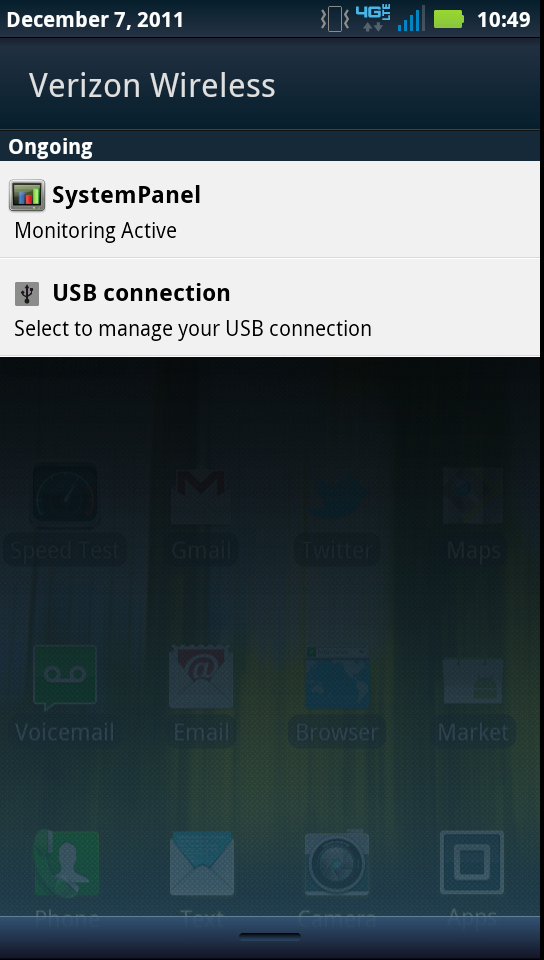
The other big change (and a welcome one) is the relocation of Motorola’s battery management and sync restriction system under the smart action umbrella. I’ve complained a few times in other reviews that both other tech press and end users are confused by the default power saving setting on the previous builds of Blur which disabled account sync between some hours. This is now totally removed and again an optional smart action (battery extender or nighttime battery saver). Instead, under settings is “battery information” which just gives you the percentage and a shortcut to Android’s battery use view.
The rest of Android on the RAZR is again much the same as other Motorola devices of this latest generation. There’s no doubt that Motorola’s suite of skins and customizations will also roll over to its Android 4.0 port - as they’ve noted in blog posts a few times already - the question is what that will look like when the time comes.
The storage situation on the RAZR is important, again you get 16 GB of internal NAND and a microSDHC port that’ll take up to 32 GB cards, and out of the box you get a 16 GB class 4 card preinstalled. Of course, that 16 GB of internal NAND can be divied up in multiple ways, but running df clears things up.
Filesystem Size Used Free Blksize/dev 460M 380K 459M 4096/mnt/asec 460M 0K 460M 4096/mnt/obb 460M 0K 460M 4096/system 636M 402M 234M 1024/pds 3M 1M 2M 1024/preinstall 605M 440M 164M 1024/data 3G 518M 2G 4096/cache 1007M 17M 990M 4096/osh 1G 1G 275M 2048/mnt/sdcard-ext 14G 432M 14G 8192/mnt/sdcard 8G 47M 7G 8192
There’s an 8 GB internal storage partition which works like an SD card (/mnt/sdcard), 3 GB for applications (/data), and then the 16 GB /mnt/sdcard-ext partition which is actually the external card. I’m assuming the rest of the space from that 16 GB of NAND is actually used for the lapdock.










76 Comments
View All Comments
mfenn - Friday, December 16, 2011 - link
Dunno how many times I have to say this, but etc. is short for "et cetera". Putting more than one period in it is just plain wrong.jordanclock - Sunday, December 18, 2011 - link
Actually, when finishing a sentence with etc. it is correct to put a second period afterward, as the first one is to indicate an abbreviation and the second is to indicate the end of the sentence. It is acceptable to use just one period, but it is not incorrect to use two.BabelHuber - Friday, December 16, 2011 - link
A question to the Anandtech guys:Why don't you ever lose a word about rSAp (remote SIM Access Profile)?
I regularily use my phones in my car, where I want to use the built-in antenna when connecting my phone via bluetooth.
Connecting via Handsfree is really a PITA: The speech quality is bad and the phone's battery is stressed.
Hence for three years now I use rSAP, first in my Audi A5 and now in my BMW 5er (via the Snap-in adapter SAP from BMW).
I still have my good old Nokia X6, this one does rSAp very well. Android, OTOH, does not support rSAP (neither does iOS), but AFAIK e.g. Samsung added rSAP-capabilities to the Galaxy line.
I know that testing rSAP is not easy because of the different systems the various Auto makers use, but it would even be interresting if you could test it at least a little bit (e.g. checking if the Adress Book synchronization works or if one has to use the SIM card itself).
A phone without rSAP is useless for me, but perhaps I am part of a small minority, who knows.
Have you had any thoughts on rSAP?
Conficio - Friday, December 16, 2011 - link
Where are you located? I have not heard about that tech.But sounds very interesting. Especially as there is a big debate going on in the US about driving and using the phone.
BabelHuber - Friday, December 16, 2011 - link
I'm located in Germany, but I would think that rSAP is a global tech.It supported by VW/ Audi, Mercedes and BMW. For BMW, you need the 'Snap-in-adapter SAP', though.
With rSAP, the phone is put to standby-mode, since the phone itself is in the car. The car gets the SIM-card-information via bluetooth and also reads the address book, then you use its built-in phone.
It's a cool technology, the speech quality is very good, since the antenna of the car is used. Also there is almost no drag on the phone's battery, since it doesn't do anything at all.
The downside is that you cannot stream music from your phone to the car's stereo, you also can't use E-Mail with rSAP.
For me this is OK, though, I don't want to receive mails while driving and the car's stereo is fed by a USB-harddisk attached to it.
introiboad - Tuesday, December 20, 2011 - link
There is no technical reason for you not to be able to stream music even when using RSAP. They are 2 different profiles, RSAP and A2DP, and should be able to run in parallel. It's a limitation imposed by the car manufacturer, not by the spec.JonnyDough - Saturday, December 17, 2011 - link
Its not really a debate. Using a cell while driving should be illegal. When you're operating a vehicle that can take someone's life in a 30mph crash then your eyes, hands, and mind should be focused on the task of driving. I learned that in driver's ed and I believe its still part of the test to get a driver's license. Driving is a privilege and so many of the younger generations today have such a sense of entitlement..cheetahfox - Saturday, December 17, 2011 - link
As someone who was nearly killed because the person that hit my car was changing the radio station; there will always be distractions in a car. If you feel that Cell phones should be illegal then you should also ban all radio's, gps, cd-players and ipods. Further you should also make all cars have a single seat. We can't let someone talking to you distract you. You should also have some way to measure if a car is being driven by someone that is sleepy. It's been shown over and over again the lack of sleep is worse that drunk driving. I propose a mandatory system of cameras that monitor the driver of a car and if they detect that the person in question is sleepy and not attentive enough that they slowly cut power to the car and force them to pull over for a 30 min nap.I am taking it to an extreme but if we should ban cell phones, we should really ban many other things. Things that we would never ban, like more than one person in a car. The problem isn't the device, it's the person using it. If the person driving is a distracted driver(for whatever reason) and they cause an accident it should be handled with existing laws.
introiboad - Tuesday, December 20, 2011 - link
Remote SIM access profile is part of the Bluetooth Specification, it's just one of the profiles defined by the Bluetooth SIG. Unfortunately, RSAP never took off in the same way that HFP (Handsfree Profile) which is the profile that nearly every other phone available uses when connecting to a car.One of the reasons may be that RSAP requires the car to come bundled with a GSM baseband/radio since it only obtains the SIM info from the phone and then uses it to place calls using its own. On the other hand HFP simply instructs the phone to place the call using the phone's own GSM radio and then transfers the sound to the car. So it's clearly cheaper to include in a car since the car manufacturer doesn't need to include a Bluetooth _and_ a GSM radio.
introiboad - Tuesday, December 20, 2011 - link
As far as I know, only Symbian and Bada phones implement RSAP.